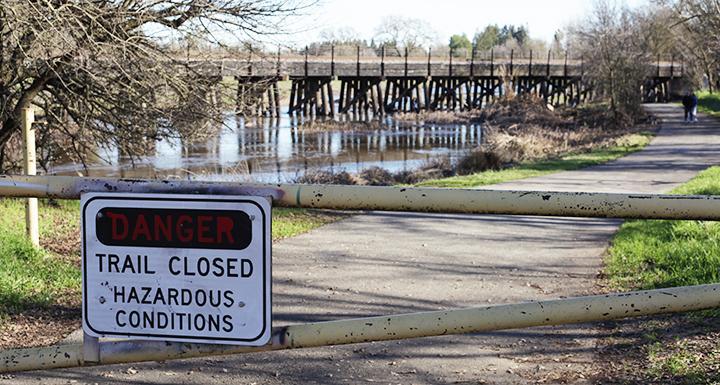California transitions from severe drought to flooding
Flooding caused by several days of heavy rainfall has caused hiking trails along Laguna Creek to close this season. With this season’s rainfall, no counties in California are currently in severe drought conditions.
Just one year ago, more than 90 percent of California was in some form of drought. With these severe droughts, Californians have had to focus their efforts on water conservation.
But after being battered by weeks of record-setting rain, these conservation efforts may no longer be necessary. Less than 20 percent of the state faces drought conditions, and no place in California currently faces “extreme” or “exceptional” drought, according to the latest U.S. Drought Monitor report.
“The last six years, California has become synonymous with drought,” said Meteorologist Karissa Klos, of WeatherNation, a cable weather channel. “But 2017 is starting off in a completely different way.”
After struggling with severe droughts over the last few years, California is now facing problems with flooding.
“Early 2017 brought a parade of storms, well above average snowfall, and rainfall that was too much at times with flooding and entire towns losing power because of all the snowfall,” said Klos, in a January weather broadcast.
The flooding has helped to relieve not only the short term drought, but it may also be impacting the long term drought in a positive way.
“If we can keep that above above average precipitation going, like much of the Western U.S. has been two to three times normal, this could be huge as we start to think not only of the short term drought, but the long term drought,” said Klos in a January weather broadcast.
An example of the recent flooding and its effects in California can be seen in the Oroville Dam flooding.
When a crater in the Oroville Dam’s main spillway threatened to flood the surrounding area, 188,000 residents were evacuated from potential flood zones.
Cosumnes River College Professor and Head of Geology Hiram Jackson said the problem with the Oroville Dam was that it was not stable enough to last under current floods.
“The problem isn’t with the dam itself,” said Jackson. “It’s with the spillway.”
The spillways are safety valves designed to release water in a controlled manner and deliver water to the Feather River in order to prevent water from spilling over the walls of the dam containing Lake Oroville.
“The spillway rarely ever flows and because of that, sometimes engineers and policy makers don’t always pay attention to it, and that’s what happened with Oroville,” said Jackson.
However, despite the heavy rainfall the state has received this year, California’s emergency drought regulations still have not been lifted.
Earlier this month, the State Water Resources Control Board extended emergency drought regulations and pledged to revisit them in May, when the traditional rainy season has ended.
“One wet year doesn’t necessarily mean that we’re out of the woods,” said Water Board Staff Max Romberg in an SWRCB board meeting as covered by Fox News. “With climate change, we have to be conserving and making conservation a way of life.”
The droughts and now the floods are also affecting agriculture, which is a big issue in California because agriculture is a major part of the economy, said Jackson.
“Increasingly, the state has limited the amount of water it would provide for agriculture during the drought, and in recent years they’ve raised the price so farmers have to pay more for water,” said Jackson.
Throughout the droughts, farmers have taken to choosing crops that will bring in more money and planting fewer crops where they might lose money, although they might choose to plant different crops now that water is more plentiful.
“On the whole, we have to take the water when it comes,” said Jackson. “It’s beneficial even though it’s causing a lot of destruction, because an even more extended drought would cause more destruction than what we’re seeing with the heavy flooding.”

